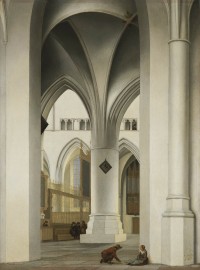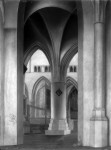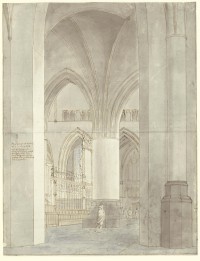 The Choir of the Saint Bavo in Haarlem (1636) by Dutch Golden Age artist Pieter Jansz Saenredam is an architectural perspective of the interior of the Gothic church of Saint Bavo. Known as the portrait painter of Dutch churches, Saenredam’s specialty was capturing the complex geometries and soaring heights of church interiors to convey their light, stillness and grandeur. Saint Bavo was one of his favorite subjects. He made about 30 drawings and 12 paintings of the church.
The Choir of the Saint Bavo in Haarlem (1636) by Dutch Golden Age artist Pieter Jansz Saenredam is an architectural perspective of the interior of the Gothic church of Saint Bavo. Known as the portrait painter of Dutch churches, Saenredam’s specialty was capturing the complex geometries and soaring heights of church interiors to convey their light, stillness and grandeur. Saint Bavo was one of his favorite subjects. He made about 30 drawings and 12 paintings of the church.
Saenredam took a rigorously mathematical approach to his church portraits. He usually made at least two preparatory drawings, one a pencil sketch done freehand in the space to establish the composition, the other a detailed graphite rendition of the scene made with a straight-edge and compass using precise measurements taken of the church by a surveyor.
An exhibition at the National Gallery of Art (NGA) in Washington, D.C., explores how the artists of the Dutch Golden Age employed drawing as part of their painting processes. The exhibition displays almost 100 drawings plus finished paintings by 17th century Dutch masters including Saenredam, Rembrandt van Rijn, Aelbert Cuyp and Jacob van Ruisdael. To prepare for the exhibition, Drawings for Paintings in the Age of Rembrandt, conservators at the NGA examined the paintings with infrared reflectography (IRR) which can reveal underdrawings made with black chalk against a white background. (Red or white chalk underdrawings cannot be detected with IRR.)
 IRR revealed an unexpected surprise in the underdrawing of The Choir of the Saint Bavo in Haarlem: a doodle of a horse carrying four men on its back and a little stick figure in balloon pants underneath them. Drawn on the left pillar in the foreground, the whimsical figures are a marked contrast to the somber whitewashed interior of the post-iconoclasm church. There’s no way Saenredam intended to paint the doodle in the final version, so he must have just been having fun knowing he’d paint over it.
IRR revealed an unexpected surprise in the underdrawing of The Choir of the Saint Bavo in Haarlem: a doodle of a horse carrying four men on its back and a little stick figure in balloon pants underneath them. Drawn on the left pillar in the foreground, the whimsical figures are a marked contrast to the somber whitewashed interior of the post-iconoclasm church. There’s no way Saenredam intended to paint the doodle in the final version, so he must have just been having fun knowing he’d paint over it.
The drawing of four men on horseback is recognizable as a scene from a Charlemagne romance. The oldest extant version of the chanson de geste Quatre Fils Aymon was written in Old French in the 12th century. It recounts the legend of the four sons of Duke Aymon of Dordogne: the chivalric hero Renaud de Montauban and his brothers Guichard, Allard and Richardet. Aymon presents his sons to Charlemagne at a royal tournament with Renaud wins. For his bravery and skill in battle, Charlemagne awards Renaud a magic horse named Bayard. The gift comes in extra handy when Renaud kills one of Charlemagne’s nephews in a fight over a chess game and is forced to flee. Magical Bayard is so big he can carry all four brothers on his back. In the end, the hero Roland convinces Charlemagne to pardon the brothers which he does on condition that Renaud expiate his sins on Crusade.
The Four Sons of Aymon was immensely popular for hundreds of years. Prose versions began to be written in the 14th century in France and the story was translated in multiple languages. The earliest known English version was printed by William Caxton around 1489. The earliest surviving Dutch translation dates to 1508. In this version it’s Duke Aymon who gives Bayard to Renaud and Renaud kills Charlemagne’s son, not his nephew.
 The image of Bayard carrying the four brothers on his back appears in art and sculpture, particularly in northern France, Belgium, the Netherlands and Germany, from the 12th century through the 20th. Not in religious art, though, and certainly not on church pillars. The Bayard doodle conveys the playful side of an artist like Saenredam almost four centuries after he covered it up.
The image of Bayard carrying the four brothers on his back appears in art and sculpture, particularly in northern France, Belgium, the Netherlands and Germany, from the 12th century through the 20th. Not in religious art, though, and certainly not on church pillars. The Bayard doodle conveys the playful side of an artist like Saenredam almost four centuries after he covered it up.
Monday is the last day of the exhibition, so if you’re in D.C. take a long lunch and pop over to the NGA to see the paintings, the IRR images and the related drawings before they move on to the Fondation Custodia in Paris. The rest of us can at least have a little fun sliding between the paintings and their underdrawings as revealed by IRR on the National Gallery of Art’s website.
Interesting that the drawing of four men on horseback had been recognisable as a scene from a Charlemagne romance, especially if Dutch translations go from 1508 onwards.
That artists doodled and amused themselves in trivial ways doesn’t surprise me at all – I play bridge hands to amuse myself. That they would go back to a Charlemagne romance is delightfully surprising. I wonder if Pieter Jansz Saenredam was a Calvinist and what sort of Church Saint Bavo was in 1636.
Happy New Year to you!
Saenredam was not a Calvinist. There is evidence in his works that he was sympathetic to Catholicism, or at least that he had several Catholic patrons over the years and was glad to include a touch of Catholicism for them . A 1628 painting of Saint Bavo, his earliest known work, includes a fictional altarpiece and stained glass window that had long since been removed from the church by the iconoclasts. This 1630 piece has a fictional bishop’s tomb with a wistful pro-Catholic inscription. There are other such nods towards pre-Reformation church decorations in other works, like the painting of the Resurrection on the church organ in this piece.
Saint Bavo was a Catholic church. It was even the city’s cathedral for 20 years before it was forcibly converted to Dutch Reform in 1578 and all its art and precious devotional objects stripped and confiscated.
Bayard and underpainting! Livius Drusus, you just keep making my day!
I love the “Matter of France”. Thank you for choosing such a fun doodle of the available ones to talk about.
Vale!
Usually underdrawings are interesting because of what they tell us of the artist’s changes to his original idea, but this one stands on its own because of how freaking charming that doodle is. I’m delighted to share in your delight. 🙂
Stunning! I’d never heard of this painter before and now I’m flipping through his works on Wikimedia Commons. Does this remind you of anyone else…
https://commons.wikimedia.org/wiki/File:WLANL_-_karinvogt_-_Pieter_Saenredam,_Interieur_van_de_Nieuwe_Kerk_te_Haarlem.jpg
An austere Dutch Piranesi?
I don’t know what access you have to BBC programmes, oh blogger, but I thought I’d tell you that we watched one this evening on the archaeology of neolithic Orkney. It was much better than usual: not mired in a slow pace and a high self-regard. It’s the first of a short series apparently.
Hi Livius.
I have a small suggestion to your web site. Maybe it would be possible to place information about the size of an object to a photo that is being shown. For example the painting “The Choir of the Saint Bavo” does not have dimensions and it is hard to judge about its size. I wonder if there is a way of placing a small caption to the image. It is exciting to know the size of the painting, photo, engraving, knife, and just about anything. If the image caption is not possible, maybe information could be placed close to object’s name in brackets. For example, The Choir of the Saint Bavo in Haarlem (1636) {16″x24″} This is just a suggestion.
Chirico!
This is really awsome. Sometimes we forget to see historical figures as complete people, taking a very one dimensional view based on what we read in history books. Things like this make us remember that these people were real and had many facets to their personalities. Very cool.
Thank you for highlighting this amazing artist. I too was inspired to look up more information about him after reading your blog. One image that others may want to view is Saenredam’s painting of the interior of the Buurkerk at Utrecht, which is apparently at the National Gallery in London. In that image a similar doodle of the four men on horseback actually appears to have made it into the final version of the painting.
A bit anachronistic though that the beggar sitting against the pillar in the front is wearing headphones :-p
Now that is my kind of surprise. I had to look this painter up. I like his rigorous approach and attention to details. This period had a very different attitude of fame and its importance. Some painters and craftsmen even preferred to remain anonymous – http://www.beazley.ox.ac.uk/tools/pottery/connoisseurship/drawings2.htm
I wonder what will posterity remember about our current era, with its informational overabundance.
Some great names will remain, sure, but what about utilitarian artists that do some industrial design or make coloring books for kids like this – http://colorkid.net/coloring-pages-around-world/coloring-pages-children-traditional-clothing ?
What a strange time we are living in.